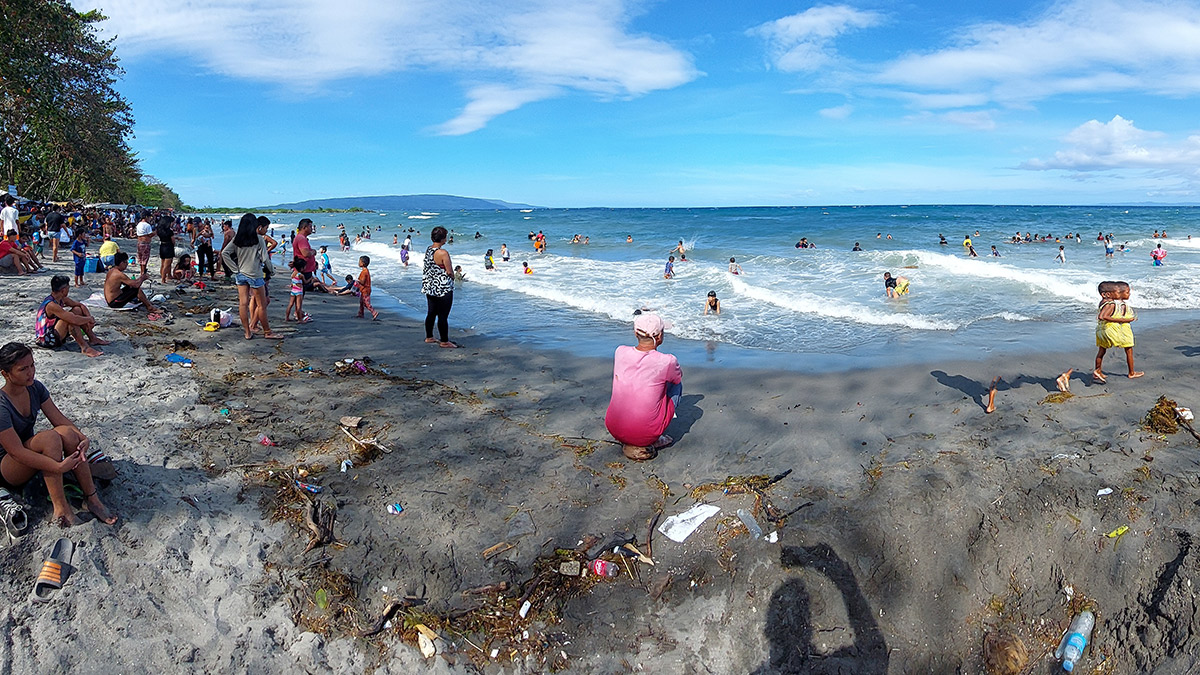Study shows Dumaguete‘s famed waterfront extremely polluted

FAVORITE SPOT Residents of Dumaguete City in Negros Oriental gather to relax or take a quick swim at Silliman Beach in Barangay Bantayan where many have spent their childhood. The water in the area was found with the E. coli bacteria far exceeding the standard set by DENR. —Photo courtesy of Moses Alcala
DUMAGUETE CITY, NEGROS ORIENTAL, Philippines — It was a place many people considered a paradise.
But the Silliman Beach in Barangay Bantayan, Dumaguete City, has changed over the years with the increase in population and human activities, and the impacts of “extensive commercial development.”
A study conducted by the Silliman University Angelo King Center for Research and Environmental Management (Suakcrem) from September 2022 to June 2023 revealed that the seabed of the Silliman Beach have consistently exhibited pollution characterized by sewer odor, foaming discharge, water coloration, and plastics and other garbage debris.
READ: Coastal villages also blamed for beach pollution in Ilocos
The study, with sampling rounds within the 340-meter waterfront, was funded by the Silliman University Alumni Council of North America, an umbrella group of alumni chapters based in the United States of America and Canada.
Article continues after this advertisementThe results of the study were presented at an alumni gathering in Atlanta, Georgia, USA, to celebrate Silliman University’s 123rd Founders Day in June this year but made available to the media only recently.
Article continues after this advertisementThe scientists—Moses Alcala, Dr. Paulina Aspilla, Abner Bucol and Dr. Socorro Parco—detected “extremely high concentrations” of E. coli and enterococci “ranging from one to five orders of magnitude exceeding the referenced standards and criteria.”
Health risks
They noted that E. coli appears to “unusually thrive in seawater” in the study area. E. coli was highest at 25,500 colony forming units (CFU)/100 milliliters. The guideline for E. coli by the Department of Environment and Natural Resources (DENR) is only 100 CFU/100 ml. The same study found enterococci bacteria up to 28,900 CFU/100 ml in seawater.
When ingested, enterococci can cause urinary tract and wound infections, meningitis and other health issues. E. coli can cause diarrhea, urinary tract infection, pneumonia, sepsis and other illnesses. Skin contact with these bacteria may cause dermatological diseases.
The amount of ammonia in all offshore seawater samples also exceeded DENR’s guidelines, which, researchers said, contributes to a “toxic environment for aquatic organisms.”
“There is a need for the public to be aware of such pollution in this popular beach,” said Alcala, a New Jersey-based environmental geologist and a visiting professor at Silliman University, in a statement.
He said he was concerned about those who frequent Silliman Beach because they could not afford the expensive resorts in the towns of Bacong, Dauin, Zamboanguita and Siaton in Negros Oriental.
Effluent standards
At Silliman Beach, many samples failed DENR’S effluent standards for biochemical oxygen demand, dissolved oxygen, ammonia, total suspended solids (water-borne particles that exceed two microns), phosphates, and oil and grease.
The researchers said an elevated amount of oil and grease in the water indicates a “possible presence of other contaminants such as volatile organics and polycyclic aromatic hydrocarbons” which are suspected carcinogens.
A rapid underwater survey conducted in the shallow seagrass beds at the Silliman Beach also found that fish biomass was low at 1.3 kilos per 500 square meters. Fish density was also low at 152 individuals per 500 square meters.
Since 2020, Suakcrem has coordinated and partly funded a number of collaborative researches with scientists and students, including studies on microplastics in food fishes collected from the Silliman Beach area.
These studies quantified the amount of extremely small particles of plastic debris in commonly-consumed fishes like the Mottled Rabbitfish (locally known as danggit, balawis) with 39 percent occurrence of microplastics, and the Zigzag wrasse (lubayan) at 14.3 percent. But researchers also noted the relative abundance of danggit at Silliman Beach, which suggests their high tolerance to pollution. Danggit, which continually grazes on seaweeds and seagrass beds, are known for adaptability to changing environmental conditions, including the presence of plastics and other trash along the shoreline and the foreshore bottom.
Once pristine
Alcala said the reports of the Silliman Beach study make him sad since he spent much of his youth learning how to swim, snorkel, scuba dive and do other recreational activities in that place.
“Silliman Beach might be more continually impacted because of the constant discharge from the polluted Mojon Creek (that separates the body of water from the runway of the Sibulan Airport),” he lamented.
Local fishers have set out to sea from the Silliman Beach to support their families with their daily fish catch. When it’s time to come home, they are met by locals in the neighborhood who want to buy only the freshest catch of the day.
Children also frolic on the beach as the adults go for a quick swim. Crews of paddlers training for their next race are also a common sight.
Senior citizens, however, said that the Silliman Beach where they had spent their childhood is not anymore the same.
After the ’70s, the structures along the Bantayan-Piapi coastal area—composed mostly of hotels, condominiums, restaurants and outdoor cafes—have led scientists to wonder if it is still safe to swim there.